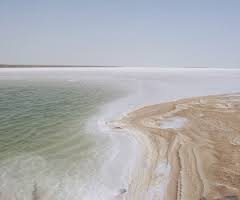The Great Rann of Kutch, is a seasonal salt marsh located in the Thar Desert in the Kutch District of Gujarat, India and the Sindh province of Pakistan. It is about 7,505.22 square kilometres (2,897.78 sq mi) in size and is reputed to be the largest salt desert in the world.
The Rann of Kutch is a geographically unique landscape that was once an arm of the Arabian Sea. As the land separated from the sea by geological forces, it became a vast, featureless plain encrusted with salt that is inundated with water during the rains. The Rann of Kutch is a unique and largest seasonal wetland of its type in India without any counterparts elsewhere in the world.
The Rann of Kutch is divided into the Greater Rann of Kutch and the Little Rann of Kutch. The Greater Rann of Kutch spans an area of 7505.22 Sq. km and is comparatively larger than the Little Rann of Kutch. The greater Rann Of Kutch is home to a wide array of flora and fauna. The Little Rann Of Kutch occupies 4,953 sq. km and is spread out in the districts of Surendranagar, Banasakantha, Patan, Kutch and Rajkot in Gujarat.
Read Also: Largest Deserts on the Planet
This is one of the hottest areas of India – with summer temperatures averaging 44 °C (111 °F) and peaking at 50 °C (122 °F). Winter temperatures reduce dramatically and can go below 0 °C (32 °F). Winter temperatures reduce dramatically and can go below 0 °C (32 °F).
It’s best to head out into the Rann of Kutch only in the early morning or evening, otherwise, the salt can be blinding. The full moon is the best time of the month to see it. A moon light Rann camel safari is magical. The Government of Gujarat hosts an annual 3-day festival called the Rann Utsav (festival of the Rann).
The Great Rann of Kutch, along with the Little Rann of Kutch and the Banni grasslands on its southern edge, is situated in the district of Kutch and comprises some 30,000 square kilometres (10,000 sq mi) between the Gulf of Kutch and the mouth of the Indus River in southern Pakistan. The marsh can be accessed from the village of Kharaghoda in Surendranagar District.
There are several wildlife sanctuaries and protected reserves on the Indian side in the Rann of Kutch region. From the city of Bhuj, various ecologically rich and wildlife conservation areas of the Kutch/Kachchh district can be visited such as Indian Wild Ass Sanctuary, Kutch Desert Wildlife Sanctuary, Narayan Sarovar Sanctuary, Kutch Bustard Sanctuary, Banni Grasslands Reserve and Chari-Dhand Wetland Conservation Reserve.
When winter settles in the water bodies of Great Rann of Kutch turns pink with the reflection of the drifting Flamingos. It is the only place in India where these feathered beauties lay eggs and bring up their chicks. About 13 species of larks have been reported from Great Rann of Kutch.
Kutch is also known for its intricate and appealing handicrafts. Rann Utsav is the ideal time to purchase the handicrafts since artisans from many parts of Kutch will flock the region with their best piece of work. Each of these brilliant crafts stands testimony to the creative ingenuity of the artisans of Kutch. The region has a great history of foreign trade in handicrafts with various countries. Even today the artifacts of Kutch have great demand in the national and international markets. Ethnic style embroidery, hand block painting, wood carving, silver work, pen-knives and nut crackers and sea shell toys and it goes on.
Also, Read:



